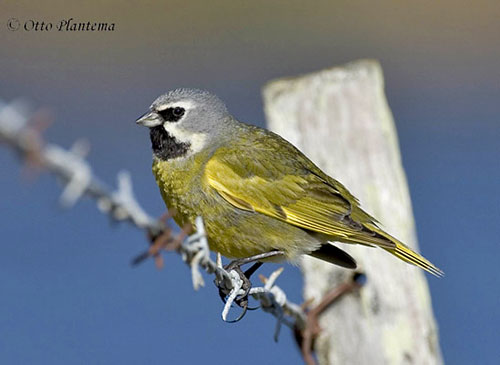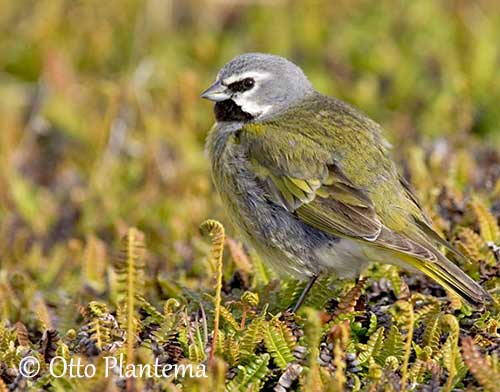
Fr: Mélanodère à sourcils blancs
All: Schwarzkehl-Ammerfink
Esp: Yal Cejiblanco
Ita: Fringuello golanera
Nd: Magelhaengors
Sd: Gulvingad patagonfink
Photographers:
John Anderson
John Anderson Photo Galleries
Otto Plantema
Trips around the world
Illustration: John Gould: 1804-1881
Text by Nicole Bouglouan
Sources:
HANDBOOK OF THE BIRDS OF THE WORLD Vol 16 by Josep del Hoyo- Andrew Elliot-David Christie – Lynx Edicions – ISBN: 9788496553781
BIRDS OF SOUTH AMERICA – Passerines - by Robert S. Ridgely and Guy Tudor – HELM Field Guides – ISBN: 9781408113424
BirdLife International (BirdLife International)
Wikipedia, la enciclopedia libre
Melanodera melanodera
Passeriformes Order – Thraupidae Family
INTRODUCTION:
The White-bridled Finch is now included in the Family Thraupidae. This species is scare and local. It occurs both in extreme S Argentina and S Chile, and also on Falkland Islands where they are more numerous, especially in coastal regions.
It is also named Black-throated Finch and Canary-winged Finch.
DESCRIPTION OF THE BIRD:
Biometrics:
Length: 14-15 cm
Weight: 25-35 gr
The adult male has greyish-olive upperparts with pale yellow edges to wing-coverts and flight feathers. But the closed wings look mostly yellow. The rump is more greenish. The tail is yellow-olive with pale yellow outer rectrices.
On the dull yellow underparts, mid-breast and belly are yellow, with grey side of breast and flanks. Lower belly and undertail-coverts are white.
On the head, crown, nape, hindneck and ear-covert area are grey. We can see conspicuous white supercilium and malar stripe outlining the black lores and the black throat patch.
The two-tone bill has blackish upper mandible and blue-grey lower mandible. The eyes are dark brown. Legs and feet are blackish.

The female is much duller, mainly buffy-brown on the upperparts, with heavy blackish streaking. The underparts are whitish with brownish streaking, and the breast is slightly washed buff. On wings and tail, yellow is more reduced and duller than on male.
The head is brownish and streaked buff, with whitish area around the eye and creamy-white submoustachial stripe.
The juvenile resembles female but it has more heavily streaked plumage and duller bill.
The immature shows more yellow on wings and tail, and it has greyish face.
SUBSPECIES AND RANGE:
Two subspecies:
M.m. princetoniana is found in S Chile and S Argentina. This race is brighter than nominate, with grey areas mostly blue-grey, broader yellow edges to flight feathers and more extensive yellow on the upperwing. Yellow is also brighter and more extensive on the underparts.
M.m. melanodera (here described and displayed) occurs in Falkland Islands.
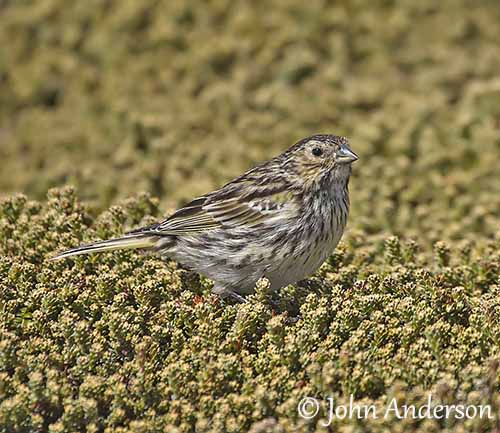
HABITAT:
The White-bridled Finch frequents open dry grassland with tussock grass and pastures, from sea-level up to 500 metres of elevation.
In Falkland Islands, it usually prefers the coastal regions and occurs in heathland, grassy areas around beaches and dunes with tussac grass Poa flabellata.
CALLS AND SONGS: SOUNDS BY XENO-CANTO
The White-bridled Finch’s call is a soft, high-pitched “tsip”.
The nominate race utters a plaintive phrase “peeoo-payoo-payoo…” repeated 2-3 times and mainly during the breeding season.
The song of the race “princetoniana” is also a repetitive series of clear whistled notes “cheet-cheet-wheerip, cheet-cheet-wheerip” uttered in slightly hesitant cadence.
BEHAVIOUR IN THE WILD:
The White-bridled Finch is often seen in small groups while foraging on the ground among tussock grass. It feeds mainly on seeds and arthropods. Its strong bill is well adapted to a wide variety of seeds.
On Falkland Islands, it feeds on seeds of various grasses and berry seeds.
It forages on the ground alone or in pairs during the breeding season, and in flocks of about 20 birds outside this period. However, large flocks of up to 1000 individuals have been observed once in Falkland Islands.
During winter in S Chile, it may form mixed flocks with the other “melanodera” species, the Yellow-bridled Finch (Melanodera xanthogramma).
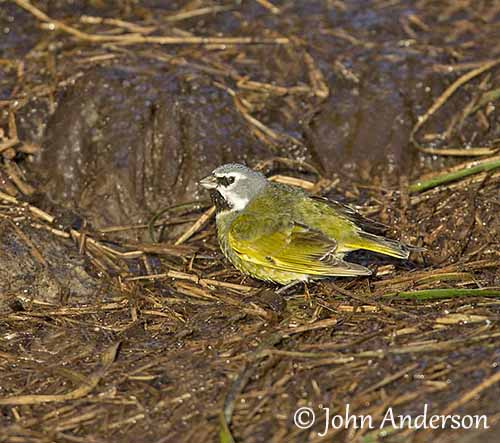
During the breeding season, the male becomes terrestrial. It often stays close to its mate during the egg-laying period. The female usually performs most of nesting duties, building the nest and incubating the eggs.
The courtship displays are unknown, but we can suggest that the male displays in order to expose and enhance the bright head pattern and the black throat patch in front of the female.
The White-bridled Finch is sedentary in Falkland Islands. The continental race usually remains at same latitudes all year round, only performing short altitudinal movements.
REPRODUCTION OF THIS SPECIES:
The breeding season occurs between October and January on mainland and between September and late December on Falkland Islands where this species usually produces two broods.
The female builds the nest with grasses and the lining is made with down. It is placed on the ground, well hidden among the vegetation or in rock crevice.
She lays 3-4 pale blue-grey or greenish-grey eggs with darker markings. There is not information about incubation and fledging periods, but the chicks are fed by both parents.
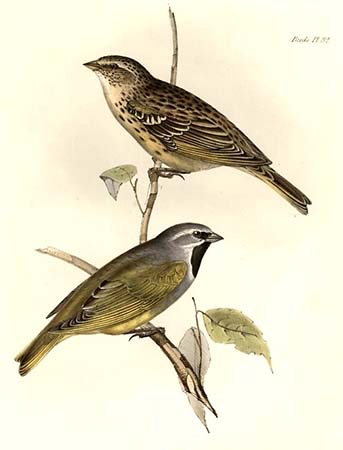
PROTECTION / THREATS / STATUS:
The White-bridled Finch is still threatened by introduced rats and cats on Falkland Islands, and by grass burning which probably destroys numerous nests.
The mainland birds are affected by overgrazing by sheep which reduces the grass across their habitat. The world population is unknown.
But currently, the White-bridled Finch is evaluated as Least Concern.
